You are currently browsing the category archive for the ‘matches’ category.
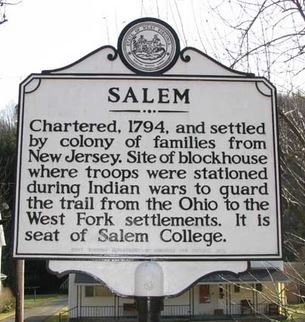
Historical marker Main Street, Salem, WV
We have two new Y matches. The first is originally from Harrisville, Ritchie County, WV and the second is from Gallia County, OH, across the Ohio River that separates OH and WV. Both these areas were located along the migration trail taken in 1787 from Monmouth County, New Jersey to Salem, Harrison County, WV.

Salem to Harrisville, WV and Salem to Gallia, Ohio
First Y match’s Davis line from Harrisville, Ritchie, WV
The first Davis Y match is a targeted tester, a 2nd cousin of a man who has been an interested William Davis DNA Project follower for some time. This interested WDDP follower first contacted me in 2014, asking about how to verify his line if he did not carry the Davis surname. His mother had been a Davis and her paper trail led back to the larger known Davis family.
This Davis enthusiast later did an autosomal test and matched several of the testers who were Davis descendants. Although matching autosomally is not conclusive proof, when coupled with his family history and ancestors’ locations in WV, we were pretty sure his line led back to Rev. William1 Davis.
The targeted tester, who does carry the Davis surname, Y-tested and does match our William Davis subgroup haplogroup of I-P37 (L-160), so we are even more sure our enthusiast is a Davis descendant.
Our Davis enthusiast and his second cousin both descend from the same great grandfather, Daniel Newton8 Davis. Daniel N. Davis was born abt 1863 in Ritchie County, WV, died in 1943, and was buried in the Odd Fellows Cemetery, Harrisville, Ritchie County, WV. He was a farmer and had married twice. He had four children with his first wife and six children with his second wife. Both our Davis enthusiast and his second cousin descend from the second wife’s six children.
 Daniel Newton Davis, 1863-1943 Harrisville, Ritchie County, WV
Daniel Newton Davis, 1863-1943 Harrisville, Ritchie County, WV
The line that Daniel Newton Davis descends from might sound familiar. See if you recognize it.
Daniel’s father was Lemuel7 Davis, born 1822 Harrison County, VA (later WV) and died 1900 Ritchie County, WV.
Lemuel’s father was Joshua J.6 Davis, who was born 1791 in Shrewsbury, Monmouth County, NJ and migrated to Salem, VA (WV) after the first group left.
Joshua J. Davis’ wife of 46 years, mother of 7 children, was Catherine Maxson, born 1797, Salem, Harrison, VA (WV), dau of Zebulon Maxson, Jr. and Mary Davis, who were part of the migration. (Zebulon Maxson Jr. was grdson of Rev. John2 Davis, and Mary Davis was dau of Rev. Nathan4 Davis).
Joshua J. Davis had a second wife, Delila Clark. She was the mother of 4 more children and outlived him to apply for his War of 1812 pension.
So, are Joshua J. Davis and wife, Catherine Maxson, starting to sound familiar? Here’s a hint:
Joshua J. Davis’ parents were William Gifford5 Davis,”Jersey Billy” (born 1762 Manasquan, New Jersey) and Catherine Johnston (born Shrewsbury, NJ).
The line is familiar because we had a previous tester, actually one of our first targeted testers, from Buckhannon, Upshur, WV, who descended from this same line. This earlier tester from Buckhannon descended from Zebulon7 Davis, who was Lemuel7’s brother. The Buckhannon tester had tested in 2009. (We’ve been at this 10 years! Can you believe it?)
Coming forward, toward the present, on the Buckhannon tester’s line, Zebulon7’s son was John Robert8 Davis (picture below), whose son was Virgil Roy9 Davis, and gdson was Londes Roy10 Davis. Londes’ son was the living tester11. So this line of Joshua J.6 Davis is confirmed for a second time as being part of the William Davis family, thanks to our new tester’s results matching our Rev. William Davis haplogroup, I-P37.
 John Robert8 Davis, born 1859 WV, with Londes Ray Davis
John Robert8 Davis, born 1859 WV, with Londes Ray Davis
Joshua J.6 Davis’ line continues into the past.
Joshua J.’s father was William Gifford5 Davis.
William G. was the son of Rev. Nathan4 Davis Sr., b 1740 RI and Anna Gifford, born in New Jersey and both died, after migrating, in Salem, WV.
Rev. Nathan was the son of Thomas William3 Davis, born 1719 RI, who died in 1791 in White Day Creek, Monongalia, WV, on the way to Salem, WV. Tacy Crandall, Thomas’ wife, died just 4 years later in 1795.
So almost back to the start,
Thomas William3 was son of Rev. John2 Davis, (born 1692, Chester County, PA) and Elizabeth Maxson.
Rev. John2 Davis was the son of the first Rev. William1 Davis who was born in Wales 1663, and who came to Philadelphia, PA in 1684. Rev. William moved to Westerly, RI and Stonington, CT, two towns just across the river from each other, coming back to PA a couple of times, finally moving to Shrewsbury, Monmouth County, New Jersey in 1743, where he died shortly afterwards in 1745.
On the map, you can see that the places of origin of our current tester and our previous tester are both close to Salem, WV: Harrisville, about 36 miles West of Salem and Buckhannon, about 42 miles South of Salem.
Salem, WV to Harrisville, WV and Salem, WV to Buckhannon, WV
So welcome new tester, and thank you, enthusiastic second cousin, for your interest and collaboration. You both have a new Davis cousin on your line who lives in Buckhannon, WV!
Second Y match’s Davis line from Gallia County, Ohio
While you’re looking at the map above, see where Gallia County, Ohio is on the western part of the map? This is where our second new Davis Y match originated.
 Named for the French people who originally settled there, “Gallia” is the Latin word for Gaul, the ancient region of Western Europe that included present day France, according to Wikipedia. Apparently some land prospectors named the area hoping for a French group to settle in Gallia County, OH. But turned out the sellers didn’t have proper ownership of the land and when the settlers arrived with their deeds, the poor settlers had to buy their land again from the actual owners.
Named for the French people who originally settled there, “Gallia” is the Latin word for Gaul, the ancient region of Western Europe that included present day France, according to Wikipedia. Apparently some land prospectors named the area hoping for a French group to settle in Gallia County, OH. But turned out the sellers didn’t have proper ownership of the land and when the settlers arrived with their deeds, the poor settlers had to buy their land again from the actual owners.
This second Y match’s daughter said that her paternal Davis line originated in Gallia County, Ohio, but how those Davises connect to our original Davis family is a bit of a mystery.
Her Davis great grandfather had a distinctive name: “Jacob N. M. Davis,” b 1851, Jefferson County, OH and died in Gallipolis, Gallia, OH. The middle initials stand for Jacob “Neff Mahlon” Davis.
 Jacob Neff Mahlon Davis, 1859-1936 Gallia, Ohio
Jacob Neff Mahlon Davis, 1859-1936 Gallia, Ohio
Jacob Neff Mahlon Davis, wife Maggie Sluyter, Ruth, Willie, Sadie, Walter, Ohio Tnsp, Gallia County, OH, abt 1898
According to the 1900 Ohio, Gallia, OH census, Jacob was a teacher. He was the son of parents William Keer Davis (b 1819 Ohio, died 1887 Gallia County, Ohio) and Ruth E. Elliott.
 William Keer Davis, 1819-1887 Gallia County, Ohio and Ruth Elliott
William Keer Davis, 1819-1887 Gallia County, Ohio and Ruth Elliott
But who are the parents of William Keer Davis?
A few family trees on Ancestry claim William Keer Davis’ father was a William Davis who was born 1785 PA, with wife Mary Milligan from Wales. You know Ancestry trees, no documentation. No proof whatsoever that William Davis b 1785 PA is the parent of William Keer Davis. And no parents of William b 1785.
But one actual source, North America, Family Histories, 1500-2000 on Ancestry, says that William Keer Davis’ parents were Jacob Davis and Mary Stuart Kearr. Is a printed family history more reliable than an Ancestry family tree? Yes, although they can be wrong sometimes also. But let’s follow it and see where it goes.
This Jacob is listed as born in 1795, near Chadd’s Ford, Delaware, PA and died May 1865, Colerain, Belmont, Ohio. Jacob Davis and Mary Stuart Kearr had 12 children and one of them was named Benjamin W. Davis!
I brake for Benjamins!
Benjamin W. Davis? I brake for Benjamins! That name is one of our unsolved mysteries, a Davis line who we haven’t been able to connect to the original Davis family… yet. Well this Benjamin W. Davis can’t be the one who we have been searching for all these years because this Benjamin W.’s father, Jacob Davis, was born in 1795. The Benjamin W. Davis we are always on the lookout for was born in 1786. No cigar there.
But it gets a bit more intriguing because, according to the same North America, Family Histories, the parents of Jacob Davis (b 1795) are Benjamin Davis and Hannah Ann Hannum. So Jacob’s son, Benjamin W. Davis, was named after his grandfather, Benjamin. The source says that grandfather Benjamin Davis was born 1777 in Chester County, PA and died in Feb 1829, East Palestine, PA, about 3 hrs northwest of Chester County.
And, if (IF!) we can trust this source as being accurate, the parents of grandfather Benjamin Davis are listed as:
Joseph Davis and Hannah Cloud, Joseph can be calculated to be born in the years from about 1732 to 1757 (if he were the age of 20 to 45 in 1777).
Don’t we know someone else who was living in Chester County, PA (near Philadelphia)?
Oh yes, Rev. William, himself, from 1699-1702 and from 1717-1724.
Rev. William did have a son named Joseph, (Joseph2), who was born in 1729 in Rhode Island. And this Joseph2 had been in PA, because Susie Nicholson says he “returned” to Shrewsbury, NJ, from PA, in 1747 (age 18). But Joseph2 supposedly later moved to Rhode Island in 1752. Joseph2 would have been 48 when this Benjamin was born in 1777, so he is the correct age, but it’s hard to be in Rhode Island and PA at the same time.
Can we speculate that our Joseph2 is Benjamin’s father? Not really. Making a conclusion from only the name Joseph Davis, in the large state of Pennsylvania, is not exactly solid research. Joseph is a very common name, even on just our own Davis family tree. Especially when Joseph2 is documented as living in RI in the years around 1777.
We can’t even prove that the parents of William Keer Davis are Jacob Davis and Mary Stuart Keear. So this is a very shaky line. But it could be one to build on. Since this line takes us to Chester County, PA, close to the correct years for Rev. William Davis’ adult children, it seems worth researching further.
We know that this Gallia line leads back to some Davis male of the Rev. William Davis family since the descendant’s Y test matches our haplogroup, I-P37, but more research will be required to figure out which Davis son is the connection.
Lack of facts for this line leaves us at a temporary end of the line, where the records end and the misty clouds of the past appear.

Clouds of the Past, (photo, Simon Migaj)
Luckily, there seems to be no end to the number of Davis family members we might uncover, if autosomal results are any indication.
Autosomal tests don’t break down brick walls, they just fly over them and connect you directly to a descendant of a Davis line, often with a detailed tree. I am confidant that this line, and our other unplaced lines, will eventually be identified through autosomal matches when the databases grow even larger. And how satisfying those discoveries will be!
Thanks to Tim Davis, in Maryland, for his sleuthing and financing to find this tester. The project is grateful for his generosity and dogged persistence!
Corrections, additions, reactions, interesting thoughts or photos, related to this post, happily accepted.
* * * *
Reconstructing the Davis Family Relationships

Reconstructed Fort New Salem in Salem, Harrison, WV (photo: WVExplorer)
“…Fort New Salem is a living history outdoor museum…
Salem was originally settled in 1792 by a group of
Seventh Day Baptist families from Shrewsbury, NJ…” -Wikipedia
It has been an honor to document the lives of our Davis ancestors who pioneered out into the unknown lands of “Virginey” for a better life. Thanks to being able to study the large Davis family tree of many lines who all funneled back to the original Rev. William Davis family and being able to reconstruct their relationships, my Davis research is now taking me in a related, but new direction.
In the future, I’m going to try a different approach. For now, I plan to focus my research on only one specific branch of the Davis family, one that I have been studying for some time and one that is currently not well known. I hope that you will find my latest Davis search as interesting as I have found it. It has been a long time coming!
The Davis families “go West,” 1789-1792
In 1789, a group of Davis families and others who were members of the Seventh Day Baptist Church in Shrewsbury, Monmouth County, New Jersey, decided they were going to try their luck by “going West.”
“West” was Virginia (the area that is now West Virginia), and the route to Virginia went through Pennsylvania, the first state west of New Jersey. Why they left was never put in writing but the most obvious reason was the Revolutionary War. It had just ended in 1783.
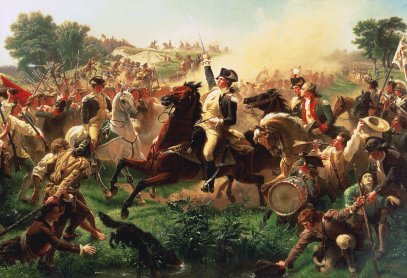 Washington Rallying the Troops at Monmouth
Washington Rallying the Troops at Monmouth
by Emanuel Leutze. Monmouth County, New Jersey, 28 June 1778 -Wikipedia
Davis researcher Susie Davis Nicholson mentions in her book, “Davis, The Settlers of Salem, West Virginia, 1979,” one instance of destruction and death to the Davis family by the British. James Davis Sr., son of Rev. William, had a shipbuilding business in Monmouth County, NJ. The British burned it down, prompting James to change allegiance from Loyalist (for British) to Patriot (against the British).
This same James, born 1720, was killed, at age 58, by a “stray bullet of the British” as he rode out to watch the Battle of Monmouth, which took place in Monmouth County, the Davis family home.
Leading up to the Battle of Monmouth, Monmouth County’s people had suffered socially. Their community was torn apart when what amounted to a civil war broke out in 1777, with some Monmouth County residents fighting as Loyalists in the British Army and plotting against their neighbors, who they called the “rebels.” These Loyalists gave strategic information about local Patriots to the British, setting up their previous neighbors for unexpected deadly ambushes.
Loss of lives, business and friendships must have caused great resentment and disappointment in the Davis community.
For this or other reasons, the members of the Seventh Day Baptist Shrewsbury Church decided, on Sept 8, 1789, to leave their New Jersey home in order to “setle in the state of Verginey.”
Their destination was Woodbridgetown, Fayette County, PA, some 400 miles due west, about 7 hours by car. In their case, they were traveling with horse, mule or oxen, pulling about 70 wagons, camping out along the way. They were following an old Indian trail that went West, probably stopping wherever there was a source of water. A horse and wagon travels at the speed of a walking horse, which is about 2-3 miles per hour. That is about the same speed that a walking person averages.
So they were essentially walking across the country. In good weather, they might cover 10 miles in a day. But bad weather, difficult terrain (including at least six mountains), wagon breakdowns, sickness, deaths, births and who knows what other problems, might halt their progress for one or several days. One might also consider that there might not have even been much of an actual “road,” since these were unsettled areas.
 Although this was taken in 1920 or so, and the Davis families probably used oxen, this gives you an idea of what they might have been traveling in.
Although this was taken in 1920 or so, and the Davis families probably used oxen, this gives you an idea of what they might have been traveling in.
They left Shrewsbury in two groups: one Sept 6, 1789 and another Sept 13, 1789. They stopped for some time after arriving in Woodbridgetown, Fayette County, PA, then changed their mind about settling there. Instead, they continued south into VA (WV).
The death of Thomas William Davis (husband of Tacy Crandall), age 72, was recorded on July 1791 at White Day Creek, Monongalia County, VA (WV), 35 miles S of Woodbridgetown, almost two years after leaving NJ.
They arrived in May 1792 at Harrison County, VA (WV), another 46 miles SW of White Day Creek, almost three years after they left NJ. There they settled the village of “New Salem,” the name of which the Post Office shorted to “Salem” in 1884.
 Routes “West” from New Jersey to “Virginia” and Ohio, 1789-1792
Routes “West” from New Jersey to “Virginia” and Ohio, 1789-1792
West Virginia was not the only place to which the Davis family migrated. Some of the Davis family in this “going West” migration traveled further SW, past Salem, to Gallia, OH. Some did not go South at all. Instead they continued due West of Woodbridgetown, some 300 further miles, to Jackson Center, Shelby County, Ohio. Other branches of the Davis family had already traveled north of Shrewsbury, New Jersey and settled in Lincklaen and Brookfield, New York, and later, other Davis branches traveled even further west to Antigo, WI and out to Oregon.
One way we know these towns are accurate locations of the migration trek is because we find autosomal and Y-DNA matches from descendants of Davis ancestors who originated in these towns along the route.
Of our recent new Davis matches, 3 Y-testers and 1 autosomal, all come from places along this migration trail, including Parkersburg WV, Gallia Ohio, and Shelby County Ohio.
Let’s start with the Shelby County descendant.
In 2014, I got a query from someone whose line had originated in Shelby County, Ohio, but part of that family had returned East to Pennsylvania, losing contact with their Shelby ancestors. She gave me the name of her ancestor and asked me to let her know if I found any living descendants. She thought there were many. Her ancestor was a William P. Davis, born about 1819 in Ohio.
Well, another Davis descendant of that branch has finally appeared, from Sidney, Shelby, Ohio. Melissa Cook, daughter of Lucille Elizabeth Davis, comes from a “daughtered out” line and so has no living male Davis to test. She did test autosomally, though, and her autosomal test does match some known Davis descendants.
In her words: “Daniel was brother to my grandfather, Oliver Franklin Davis. Oliver and Sophia had my mother, Lucille Elizabeth Davis 1922 – 1981; and two sons, Arthur and Vernon Davis, but both of them adopted. That is where the Davis Male line ends on my side.”
And she brings to us a photo.
This is a photo of Daniel Webster Davis, Melissa’s great uncle, who lived in Shelby County, Ohio.

Great Uncle of Melissa Cook:
Daniel Webster Davis, born 1895 Shelby County, Ohio
(Original photo: Kelly Williams)
Daniel’s grandfather was William P. Davis, born 1819 Ohio, son of Zebulon Davis, born 1786 New Jersey.
Zebulon was the son of Rev. Jacob Davis born 1748, New Jersey.
Rev. Jacob Davis was a chaplain in the Rev. War and migrated with the group in 1789 to Woodbridgetown, at age 41. Rev. Jacob was son of James Davis, Sr. and Judith Maxson, the same James whose shipyard burned down and who died watching the Battle of Monmouth. Rev. Jacob’s wife was Mary S. Davis, daughter of Thomas William Davis born 1719 and Tacy Crandall.
Rev. Jacob Davis founded a Seventh Day Baptist Church in Woodbridgetown, PA, while their group temporarily lived there. When they continued south and founded their first church in 1792 in Salem, VA (WV), Rev. Jacob Davis was their first minister. Rev. Jacob died a year later, in 1793, en route back to Woodbridgetown to minister at his old church. His son, Zebulon, was just 7 years old.
TO BE CONTINUED. We have more testers who are descendants of the Rev. William Davis family and more stories of their ancestors who originated in towns along this migration trail! Do your Davis ancestors come from any other towns along this path?
If you are a Davis descendant and have autosomal DNA results, please contact me and I will compare your results to the autosomal results of others who are known Davis descendants. Even if you don’t need to corroborate your ancestry with DNA, your results could help place someone else’s line. And your results might possibly, one day, help determine the probable DNA signature of Rev. William Davis, himself.
Comments, corrections, further details or other responses respectfully received.
Copyright, 2019
Jan Davis Markle, M.A.
Founder, William Davis DNA Project
New Y-Match
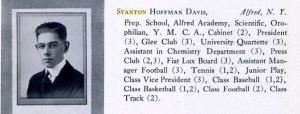 New Member’s ancestor: Stanton Hoffman Davis, Sr., Alfred U. yearbook, 1917
New Member’s ancestor: Stanton Hoffman Davis, Sr., Alfred U. yearbook, 1917
We have a new match on our Davis Y-line, thanks to Tim Davis, of Maryland, who donated his sleuthing hours and funding of the test.
This new member of our William Davis DNA Project is a young man who lives in San Diego, whose father was born in Michigan and whose grandfather was Stanton Hoffman Davis, born 1925 in Plainfield, New Jersey.
Our new member’s great-grandfather was also named Stanton Hoffman Davis, but he was Dr. Stanton Hoffman Davis. This senior Stanton Hoffman Davis was born in 1894 in Alfred, New York and attended Alfred University. See his yearbook entry above.
Stanton Hoffman Davis Sr. later went to Yale Medical school and became an Obstetrician. Stanton Hoffman Davis, Sr. died in 1980 in Texas.
Alfred University, College founded by the Seventh Day Baptists
Stanton Hoffman Davis Sr.’s father was Rev. Boothe Colwell Davis, born in 1863 in WV and died in 1942 in VA.
Rev. Boothe Colwell Davis might be a name you recognize. He was the President of Alfred University from 1895 to 1933. Alfred University is a non-sectarian college founded by the Seventh Day Baptists in 1836 in Alfred, New York.
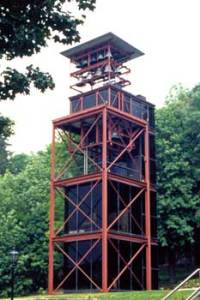
Davis Memorial Carillon, built in 1937 for Rev. Boothe Colwell Davis
A carillon is a musical instrument consisting of at least 23 cast bronze cup-shaped bells which have been precisely tuned so that many bells can be sounded together to produce a harmonious effect. -https://www.alfred.edu/map/carillon.cfm
Our new member’s Davis line descends from William1 Davis and Elizabeth Pavior via their son James2, still the only child of William and Elizabeth whose living descendants we have been able to locate and test.
Starting at the top of the tree, the line goes from James2 (and Judith Maxson) to Jacob3 (who lived in New Jersey with wife Mary S. Davis), then to Jacob4 (who married first, Prudence Maxson and secondly, Sarah Hoffman).
Jacob4’s son was Samuel5 Davis who was born in WV (married Elizabeth Fitz-Randolph). And Samuel5’s son was Rev. Boothe Colwell Davis.
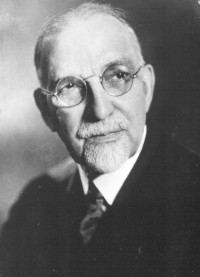
Rev. Boothe Colwell Davis, 1863 WV-1942 VA, photo abt 1933
So these Davis ancestors were part of the Davis group who left New Jersey in 1789 and traveled through PA on their way to settle their new town of Salem, VA (now WV). And, after living in WV and attending Alfred U. in NY, Dr. Stanton Hoffman Davis moved back to NJ again. Back to where his Davis ancestors lived for 45 years.
The entire 10 generations in chronological order
William1 Davis and Eliz Pavior (RI, NJ)
James2 Davis (NJ) and Judith Maxson (NJ, WV)
Rev. Jacob3 Davis, Sr. and Mary S. Davis (NJ, WV)
Rev. Jacob4 Davis and Sarah Hoffman (NJ, WV)
Rev. Samuel5 Davis and Elizabeth Fitz-Randolph (WV)
Rev. Boothe Colwell6 Davis and Estelle Winchester Hoffman (WV, NY)
Dr. Stanton Hoffman7 Davis, Sr. (NY, NJ, TX)
Stanton Hoffman8 Davis, Jr. (NJ, TX)
New member’s father9 Davis (Michigan)
New Member 10 Davis (San Diego, CA)
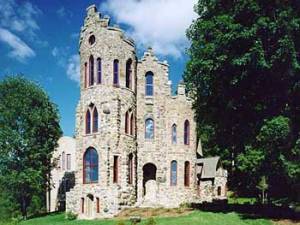 Picturesque Steinheim Castle on Alfred U. campus,
Picturesque Steinheim Castle on Alfred U. campus,
built by Ida Kenyon, completed by Jonathan Allen, 1875-76
So, welcome new member! You come from a distinguished line, amongst many distinguished Davis family lines!
See our new member’s Y-test results, compared to results of our 27 current Davis members, at FTDNA’s Davis DNA Project site. Our Davis subproject is “Davis, William, K87577.” Scroll down to the dark maroon banner.
Wonder if you’re a DAVIS?
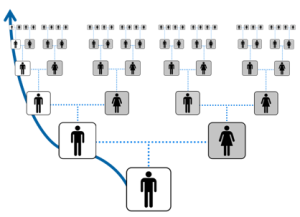 If you are wondering if you, too, might be part of the extended Davis family, there are two tests you can take. To positively prove the Davis surname line, the Y-test, only for males, is essential. It is indicated by the blue line in the graphic above that represents our haplogroup, I-L160, or I2a1b in old vernacular.
If you are wondering if you, too, might be part of the extended Davis family, there are two tests you can take. To positively prove the Davis surname line, the Y-test, only for males, is essential. It is indicated by the blue line in the graphic above that represents our haplogroup, I-L160, or I2a1b in old vernacular.
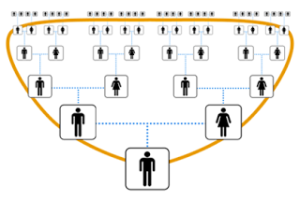 But to discover if you are a dna cousin to proven Davis family members on more than just the Y-line, you can do so with the autosomal test, which both men AND women can take. The autosomal test will find matches to Davis family descendants on all your ancestral lines, not just your paternal surname line.
But to discover if you are a dna cousin to proven Davis family members on more than just the Y-line, you can do so with the autosomal test, which both men AND women can take. The autosomal test will find matches to Davis family descendants on all your ancestral lines, not just your paternal surname line.
In the graphic above, potential matches are ALL the people, both males and females, on all lines. Autosomal tests are offered by the major companies FTDNA, AncestryDNA and 23andMe. Chromosome segment information withheld on Ancestry tests can be revealed by transferring results to FTDNA or Gedmatch.com.
If you’re considering testing, I urge you to do so. It’s a lot of fun! Since we have many Davis descendants proven by Y-tests, you can see if you match any of them autosomally. This doesn’t positively prove a Davis relationship, but it is a good step towards that conclusion.
Looking forward to finding where our Davis family will turn up next.
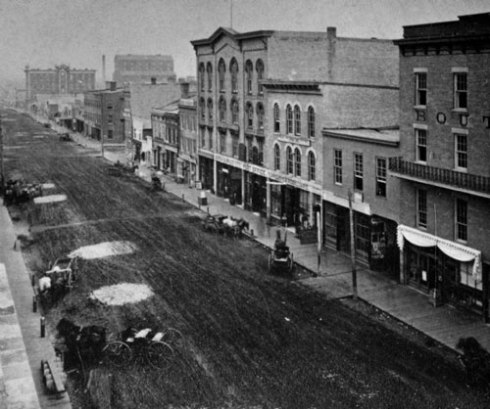
Racine, Wisconsin, 1860, 12 miles from Caledonia, home of Job Greene Davis -Courtesy Wisconsin Historical Society
Hello Davis descendants, cousins, family, researchers and interested followers,
We have received two new Y-test matches for our William Davis DNA Project since the last post. One a 67-marker test and the other a 12-marker test- they both match the standard signature of our William Davis DNA results, that of I-L160, known in old vernacular as I2a1b. This brings us to 26 Y-testing members who all match each other. Each of these 2 testers has a sister who is managing the test, so that means we have four new cousins!
Ancestors of the new matches
Both our new matches are descendants of a common ancestor, Job Greene Davis, who was born in 1799 in NY.
Job and his wife, Susan Money had 8 children and our two new matches are descendants of two of their sons: Samuel Parker Davis, born 1841 New York and Jerome Ahira Davis, born 1843 New York.
Around 1855, Job Greene and Susan Davis traveled 719 miles from Otselic, Chenango County, NY to Caledonia, Waupaca County, Wisconsin, a village 20 miles south of Milwaukee on the west coast of Lake Michigan, showing up enumerated on the 1860 census with their three youngest children. The Davis and Allied Families (Descendants of Seventh Day Baptist, William Davis) web site says that they made the trip in a covered wagon.
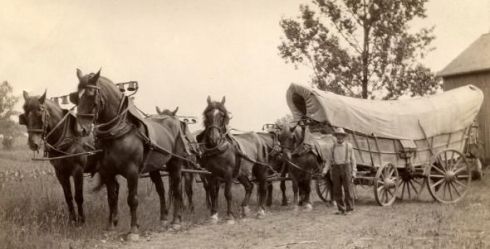 Might they have traveled in something like this?
Might they have traveled in something like this?
In 1860, Samuel Parker Davis would have been 19 and, at the time of the 1860 Caledonia, Waupaca, Wisconsin census, his younger brother Jerome Ahira was 16, Eugene 14 and the youngest, Mary Ann “Amy,” was 12. The four older siblings, 3 daughters and Nathan, were married by 1860. One older daughter, Julia, married in 1854 and stayed behind in Otselic, NY, but the rest all relocated to Wisconsin with their families.
Nathan Rogers Davis, older brother of Samuel Parker and Jerome Ahira, was listed on the same 1860 census in a separate household next door to the Job Green Davis family, also next to the Babcocks (Nathan’s wife’s parents), next to the Moneys (his mother’s family) and other extended family. Apparently they came as a group, probably all looking for the fertile farm land that Wisconsin was promoting to encourage new settlers.
Between 1860 and 1875, older brother Nathan died in 1863, leaving a widow and three children, younger brother Jerome Ahira served in the Civil War and returned to marry Eunice Dickinson and have 3 children (and later remarried Charlotte Butler and had four more children) and parents Job Green and Susan died in 1869 and 1873.
According to the Davis and Allied Families web site, Job and Susan died of black small pox and, for fear of contamination during the epidemic, their house was burned to the ground and they were buried away from the local cemetery. Their grave stones were found covered with dirt in a cornfield (“…literally dug up”) by Glenna Maria Davis Johnson and her family.
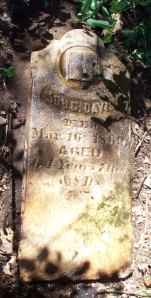
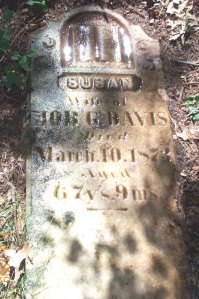
Gravestones of Job Greene Davis, died 1869 and Susan Money Davis, died 1873
-Courtesy Davis and Allied Families
From Samuel Parker Davis to Samuel Peter Davis to Stuart Edward Davis
But where is our other Y-tester’s ancestor, Samuel Parker Davis, in 1860? Not to be found until he shows up on the 1870 census with his wife Eliza Garrow, and the first two of their three children, 137 miles north, in Mukwa, Waupaca County. This was the New London area of Wisconsin, named so by the first settlers who came from New London, CT.
By 1880, Samuel Parker Davis has relocated back south to Dayton, just West of Milwaukee, and is listed as a farmer, with 3 children, one of which is our tester’s ancestor, Samuel Peter Davis, 2 years old.
Four years later, Samuel Parker Davis, who had been a farmer, died early, at age 43. His son, Samuel Peter, was only six years old. Samuel Peter Davis later married Inez Schachte and they moved to Superior, Douglas County, Wisconsin, 389 miles north of Dayton where he made his living as a plumber.
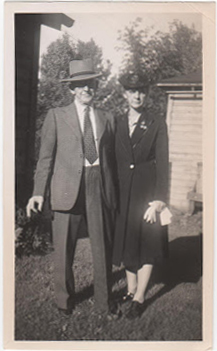
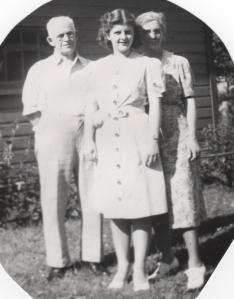
Samuel Peter Davis, Inez Hildegarde Schachte, and daughter Marjorie
–Courtesy Mary Lee Davis La Blanc
Samuel Peter Davis and Inez had two daughters and a son, Stuart Edward Davis.
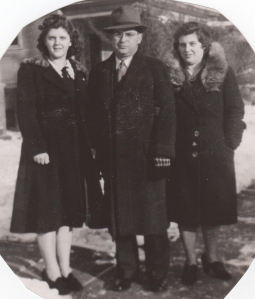 Stuart Davis with sisters, Dorothy and Marge
Stuart Davis with sisters, Dorothy and Marge
–Courtesy Mary Lee Davis La Blanc
Perhaps because Stuart grew up in the Great Lakes coastal town of Superior, as an adult he chose to work on the Great Lakes for the Interlake Steamship Company. He worked on the lakes from March through much of December and, according to his daughter, loved his job. Stuart Edward and his wife Margaret McDonald, also had 3 children, one of whom was our tester.
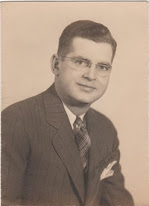 Stuart Edward Davis, 1911-1981
Stuart Edward Davis, 1911-1981
-Courtesy Mary Lee Davis La Blanc
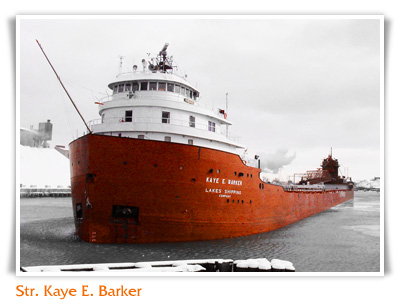
-Courtesy of the Interlake Steamship Company
From Jerome Ahira Davis to Orson Jerome Davis to Walter Orson Davis to Glenn George Davis
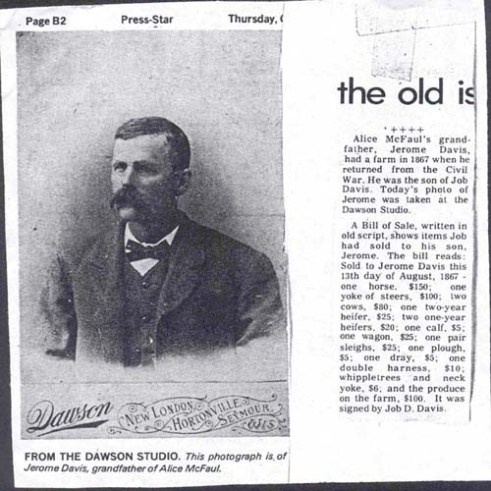
Jerome Ahira Davis, after the Civil Wall, New London, Wisconsin
-Courtesy Davis and Allied Families
The oldest son of Jerome Ahira Davis, Orson Jerome Davis, married Stella Kent and had 6 children. They lived in Caledonia and then Mukwa, Wisconsin. Orson’s occupation is listed in 1930 as a farmer on a general farm at home. Orson Jerome Davis and Samuel Peter Davis were first cousins. Did the 307 miles between Superior and Mukwa affect how much they stayed in contact?
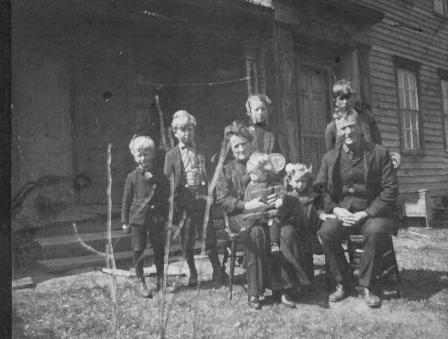
Orson Jerome Davis, Stella (Kent) Davis and children: Chester, George, Jennie, Walter, Hazel and Doris about 1906. -Courtesy Davis and Allied Families
Walter Orson Davis, Orson Jerome’s first son, was born in 1891 in New London, Wisconsin and he died there in 1954. On the 1930 census, Walter was listed as a dairy farm laborer and in 1942 he was self-employed. In 1940, he and his family are living in Royalton, Wisconsin, only 12 miles from Mukwa, where Walter’s father, Orson Jerome, had moved in 1895.
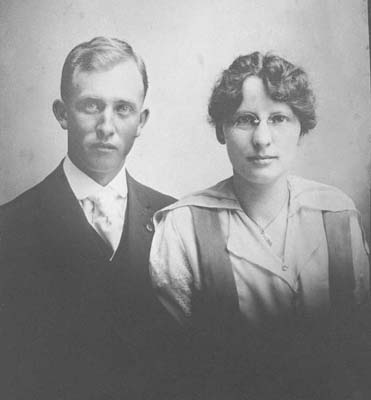 Walter Orson Davis and Frances (Henry) Davis,
Walter Orson Davis and Frances (Henry) Davis,
wedding photo, 1917
-Courtesy Davis and Allied Families
Walter Orson married Frances (Henry) Davis and they had 6 children, one of which was our tester’s father, Glenn George Davis, born in 1929.
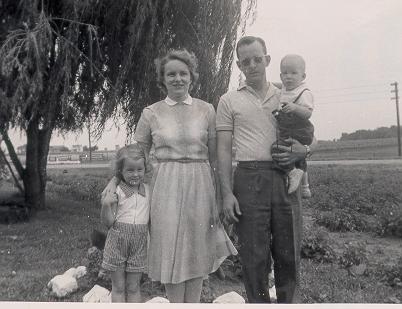 Glenn and Nancy (Eckstrom) Davis family, Sugar Bush, WI, abt 1959 with tester and tester’s sister
Glenn and Nancy (Eckstrom) Davis family, Sugar Bush, WI, abt 1959 with tester and tester’s sister
-Courtesy Davis and Allied Families
If this line is sounding familiar, it’s because we had a tester early on in our project history who also descended from Walter and Frances (Henry) Davis. This early tester was the son of Ward Rexford Davis. Ward was the older brother of Glenn George Davis, so our current 67-marker tester is a first cousin to our earlier tester. The father of our current tester and the father of our earlier tester stand next to their sister in this family photo.
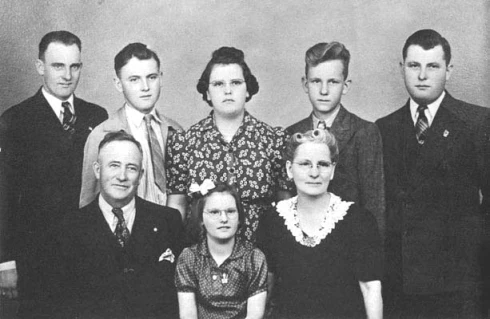
Walter Davis family, abt 1942. Front: Walter Davis, Lois, Fannie (Henry) Davis. Back: Kenneth, Ward, Verna, Glenn, Donald
-Courtesy Davis and Allied Families
Comparison of Results
Both our new testers’ results match the results of all our previous members of the William Davis DNA Project, indicating that they are both descendants of the original William Davis. See how the markers match up in our William Davis K87577 subgroup on the Davis Surname Project website.
Unfortunately for our analysis attempts, one of our new matches, the descendant of Samuel Parker Davis, is a 12-marker-only tester so we won’t be able to make any astute comparisons between them. Actually, the 12-marker tester also tested two additional markers as part of the advanced testing process, so it was more accurately a 14-marker test.
One interesting aspect of the results was that the 67-marker tester, the descendant of Jerome Ahira Davis, showed double values for his DYS #385, an unusual occurrence, which our Davis Surname Project Administrator says, is not unknown and “happens sometimes.” What are double values? Simply that the tester shows 4 results instead of 2 results on the marker DYS #385 (“10-11-12-12” instead of “11-12”). Its significance is that this tester is, according to the testing company, probably “genetically unique,” unless another male on his line has the same mutation.
Both new testers show the exact same values on the 14 markers that they both tested, except for the double marker values. This was fairly expected since the testers are “third cousins, once removed.”
That means, three generations ago, their ancestors were siblings. (The “once removed” means one line is separated by four generations.)
If third cousins test almost the same, you’d expect the tests of the two first cousins to be exact duplicates, wouldn’t you? But our 67-marker tester is 2 steps of genetic distance off from his first cousin, the earlier tester. The double marker values at DYS 385 counted as one step off and they also had another marker with one step genetic distance.
So our 67-marker tester matches closer to Hank Raymond Davis, kit #151841 (and Hank’s two identical matches), with only 1 step off (that step being his double markers). Our tester is closer to Hank, at least a fifth cousin, than to his own first cousin. Will there ever be a rational pattern to these results?
See the chart below of simplified results that lists only markers that show differences among our testers, omitting duplicate tests. See proven lines chart to see the ancestor lines for each tester.
[Chart being updated]
“Simplified” comparison chart listing
just markers that differ among the testers
(click 2x to enlarge, back button to return)
So, welcome new William Davis descendants, brothers and sisters!
For more Davis photos, check the Ancestor Photos page.
Autosomal Tests
If it seems like it’s been a while since the last post, that’s because I’ve been busy studying how to apply autosomal testing to our project. Autosomal tests, or “A-T” tests, are the latest kind of DNA tests. The Y-tests track the father’s line, from son to father to grandfather and on up the paternal line; the Mitachondrial tests track the mother’s line, from daughter (or son) to their mother, to grandmother and on up the maternal line. But the AT test tracks all the lines, and a woman can take the test! Finally! The females can start finding their own matches.
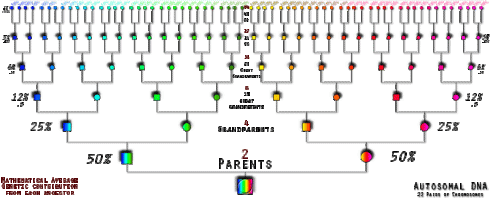
-Creative Commons License, Angela Cone
I’ve been learning how adoptees use autosomal testing to find their birth parents and have been applying their methodology for solving genealogical blocks. The method is: find the ancestors of the people who match your DNA, then, when you hit an ancestor in common for two or more of your matches, you track their lines down (towards the present), and sideways (siblings), until you find a person, in about the correct year and place, who fits the description of who you’re searching for.
The DNA doesn’t lie. If two people match your DNA on the same chromosome, and they match each other, then you know you three have an ancestor in common, somewhere. When you exchange family trees, you’re looking for who that might be. This isn’t breaking down brick walls, it’s leapfrogging over them!
What’s exciting is how many different people carry bits of the same DNA that you carry. If one match doesn’t lead to the family you’re looking for, there are many other matches to that same segment who might have the answer.
I urge any of you Davis or non-Davis surname Y-testers who have questions about how your line fits into the larger Davis family tree to take the AT test. It costs $99 at FTDNA and there is often a sale of half price during the next two holidays, so keep an eye out for it.
Even if you don’t have questions about your line, it is a lot of fun to meet people whose DNA matches yours. It’s like a genealogical social media network. You’d be surprised how far-flung our Davis cousins are. Because the Davis family migrated to several places, the Davis DNA is turning up in descendants in all those places.
We already have a few people in our project who have taken the AT test and are comparing results. Much fun! If you’ve taken the AT test, please let me know your kit number and testing company so we can compare results.
The more cousins who take the test who are known Davis matches on the Y-test or AT test, the easier it is to sort the results of the ones who need placement. If all the members tested, we might even be able to eventually anticipate the DNA of William Davis, our patriarch. (See Ancestor Reconstruction.)
Addresses?
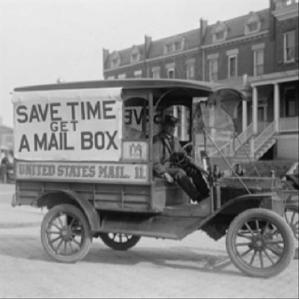 I’m still waiting for a couple of stragglers who haven’t sent me their address before I can send out something in the mail (you know, that thing that isn’t on the computer) to you all. If you’re one of those who hasn’t sent me your current address (you know who you are!), please send your physical mailing address to: jrmarkle at g mail dot com. Thank you.
I’m still waiting for a couple of stragglers who haven’t sent me their address before I can send out something in the mail (you know, that thing that isn’t on the computer) to you all. If you’re one of those who hasn’t sent me your current address (you know who you are!), please send your physical mailing address to: jrmarkle at g mail dot com. Thank you.
Until the next post or the next cousin,
best wishes,
Jan Davis Markle, Director
William Davis DNA Project
Additions, corrections or comments gratefully received in comment section.

“William Davis Pvt NJ Militia Rev War Mar 21 1758 Jan 6 1845”
Courtesy findagrave.com. Known as “Greenbrier Billy.”
Hello Davis descendants, researchers and interested followers,
We’ve got two new matches at the 67-marker level to consider and just got notice that we have another new match at the 37- marker level who we will look at in the next post, when we get all the details.
For now, we have two new matches to think about and they are both in the same neighborhood on the Brisley side of the Davis family tree. The “Brisley side” means that both testers descend from William1 Davis and his first wife, Elizabeth Brisley, via their first son, John2.
William had 4 more sons via second wife, Elizabeth Pavior, who are on the “Pavior side” of the family tree, but we have tested descendants of only 1 of those 4 sons, James2.
The ancestor in common for both new matches is Thomas “William”3 Davis, son of John2, who was born in 1719 in Rhode Island and migrated to Shrewsbury, New Jersey. He migrated again with his adult children and other Seventh Baptist families in 1789, only to die in White Day Creek, Monongalia County, Virginia, in 1791, having not yet reached Salem, (West) Virginia.
Two of Thomas William3’s 3 sons: William “Greenbrier Billy”4 and Rev. Nathan4, head up the separate lines of our two new matches.
About our first match- the green line on the chart
At the last post, we had just received news of a new match, at the 67-marker level. He is kit #219 (kit numbers are shortened to the first three numbers) and is a descendant of William “Greenbrier Billy”4 Davis.
This match’s grandfather was Deuron Clifford8 Davis and Deuron’s father was Sylvanis7 Davis, both coal miners from Coal township, Harrison County, WV.
 Sylvanis Davis, 1846 WV- 1929 Clarksburg, WV
Sylvanis Davis, 1846 WV- 1929 Clarksburg, WV
Courtesy Sharon Sprouse Bramhall
If we follow Deuron’s line up, we find Sylvanis7 was the son of Absalom6 Davis who was, in 1850, a farmer living in Doddridge County, West Virginia. His wife, Polina S.W.5, was also a Davis, a descendant of William “Bottom Billy”3 Davis. They had 14 children and adopted a fifteenth.
 Absalom Davis Bible, Births, Courtesy Sharon Sprouse Bramhall
Absalom Davis Bible, Births, Courtesy Sharon Sprouse Bramhall
Absalom’s father was Rev. Peter5 Davis, a Seventh Day Baptist minister in New Salem, Harrison Co., WV and Rev. Peter’s father was William “Greenbrier Billy”4.
(See Ancestor Photos page for images of birth, death and marriage pages from Absalom’s and Sylvanis’ Bibles.)
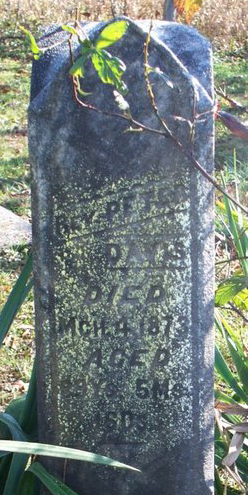 “Rev. Peter Davis, Died Mch. 4 1873, Aged 89 Ys, 5Ms 16Ds”
“Rev. Peter Davis, Died Mch. 4 1873, Aged 89 Ys, 5Ms 16Ds”
Courtesy findagrave.com
Susie Nicholson says: “Peter Davis was about six years old when his parents [Greenbrier Billy4 Davis and Elizabeth Johnston] joined in the 1789 migration with the Seventh Day Baptist group from Shrewsbury, New Jersey to Western Virginia… He outlived both wives [Sarah Davis and Sarah Fitz-Randolph] and was cared for by his daughter, Jemima, wife of Rev. Jacob Davis.” -excerpted from Davis, The Settlers of Salem, West Virginia, by Susie Davis Nicholson, 1979, pg 32.
About our second match- the aqua line on the chart
 “Stephen C. Davis,
“Stephen C. Davis,
Born Sept. 30, 1781, Died Aug 16, 1869, Aged 87 Ys 10 Mos. 16 Ds”
Son of Rev. Nathan Sr. Davis
Courtesy findagrave.com
Our second new match, also matching on the 67-marker test, is kit #320. He is a descendant of Rev. Nathan4 Davis, Greenbrier Billy4’s older brother. Our second match’s grandfather was Howard Lee9 Davis, born in Clarksburg, Harrison County, West Virginia.
 Howard Lee Davis, abt 1918
Howard Lee Davis, abt 1918
Track this line back, all in West Virginia (“Virginia,” before 1863), and you find Howard’s father was Mingo H. 8. Mingo’s wife was Jean7, also a Davis, grand-daughter of William “Buckeye Billy”5 Davis, who was the grandson of William “Bottom Billy”3 Davis.
It’s easy to wonder where the name “Mingo” came from since it is such an unusual name, especially in 1871 when Mingo H. was born. With no stories handed down in the Davis family about its origin, a bit of research finds that there is a county in West Virginia named “Mingo” but it was formed in 1895. Mingo H. Davis was already 24 years old in 1895.
The other mention of the name Mingo is that of an unincorporated area in West Virginia called “Mingo,” or “Mingo Flats,” which was named after the historic Iroquoian Mingo people who migrated west to Ohio around 1750. Mingo Flats had apparently been the site of one of their villages. The migrants were called “Mingos,” a corruption of “mingwe,” originally meaning “chief” or “greatest,” later meaning “colonial,” referring to their Iroquoian outpost in WV.
Descendants of the settlers of Mingo Flats had stories handed down from their ancestors about the ancient Mingo village and, in 1920, wanted to honor its existence by erecting a statue.
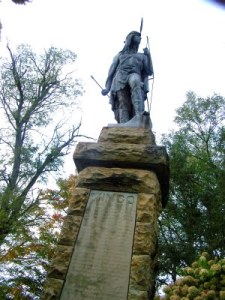 Being that Mingo Flats was not very far from Clarksburg, Harrison County, might it be that those same stories, much more vibrant in 1871, were the inspiration for the name “Mingo H.?”
Being that Mingo Flats was not very far from Clarksburg, Harrison County, might it be that those same stories, much more vibrant in 1871, were the inspiration for the name “Mingo H.?”
Going further up the line, we find Mingo’s father was Mark7. During the Civil War, Mark Davis was in the Confederate Cavalry while his brothers served in the West Virginia Militia and Union Army. And after the war, they went back to being neighbors. Mark’s father was David D.6. On the 1850 Doddridge County, Virginia census, David D. Davis’ occupation is listed as “Toll Gate No. 10.”
David D. and Absalom, ancestors of these two lines, were 2nd cousins, born within 5 years of each other and both lived in Doddridge County, VA in 1850. They probably knew each other well.
David’s wife was Anna5 Davis, also a descendant of William “Bottom Billy”3 Davis, leading us to Stephen C.5 .
Stephen C.5 is the ancestor in common for lines #2 and #3. He was the son of Rev. Nathan4, Greenbrier Billy4’s older brother.
That’s a lot of Davis ancestry in one line!
Follow the lines on a chart
On the chart below, the new tests are lines 2 (aqua) and 5 (green), highlighted with red shadow.
Testers on this chart have been placed in sequence of oldest to youngest, left to right. At each generation, the oldest son and his descendants are listed first, on the far left of tree, and the youngest son and his descendants are listed last, on the far right of tree. This places testers descending from the same ancestor in common next to each other.
Who do you think will match?
1. We would expect new tester #320, line 2, to match closely to previous tester #275, line 3 (aqua lines) because they descend from brothers at gen 6 (Brothers are David D.6 and Nathan G.6.)
2. We would also expect new tester #278, line 5, to match closely to previous tester #219, line 6 (green lines) because they descend from brothers at gen5 (Brothers are Rev. Peter5 and George Johnston5).
Lineage chart of 2 new matches (shadowed red)
[Chart being updated]
(Click 2x to enlarge, back button to return)
Comparison of results
and some questions to ask
Now that we have the lines, let’s compare the DYS values, possibly answering some questions:
1. How close will the lines match?
2. Are there any markers or combination of markers that distinguish any lines from each other?
3. Do the markers display the relationships that we already know?
That is, if you didn’t know who the new matches descended from, could you predict their probable lines from their DYS results?
DYS Marker Comparison
As we gain more testers, our test comparisons get more complex, so this bit of analysis may take some patience. (Not the usual webpage sound bites here).
A chart is the best way to compare markers but it’s hard to see patterns in a large chart with 67 markers. So, to simplify the results, the following is a smaller chart of our group’s 12 changing markers only.
- The marker results that all testers had in common were omitted, duplicate tests were omitted, less than 67-marker tests were omitted and non-Davis tests with many mismatches were omitted.
- The testers were sorted by line and color-coded by ancestor in common (matching colors of the lineage chart). Marker results were colored by type: anomaly results (only one or two testers show that marker result) were colored yellow, unusual results colored green, variations in marker values colored shades of blue and identical marker values colored pink.
- The order of DYS columns was changed to line up same-value markers together. Fast-changing DYS names are in red text.
[Chart being updated]
(Click 2x to enlarge, back button to return)
- Rev. Nathan4’s four lines, are the first four rows. (The first two rows, colored blue and light blue, are lines 1 and 4, both previous testers.)
- The 3rd and 4th rows, colored aqua and light aqua, are line 2 (with new tester #320) and line 3.
- The 5th and 6th rows, colored green and light green, are Wm Greenbrier Billy4’s two lines, line 5 (with new tester #278) and line 6.
- The other rows, purples, pinks and golds, are other previous testers‘ lines.
Move back and forth between the lineage chart of new lines and this DYS marker chart to get a feel for how the markers reflect the lines that they represent.
Analysis of Results
So what do we find?
1. How close do the new lines match?
New tester, kit #320 on line 2 (aqua), does match kit #275, on line 3, but with 2 steps off, a bit more genetic distance than expected.
In 6 generations, there were 2 mutations.
New tester, kit #278 on line 5 (green), does match kit #219, on line 6, with 1 step off, as expected.
In 6 generations, there was 1 mutation.
2. Can the lines be distinguished by their DYS results?
- Yes. On new line 2, (kit #320, aqua), DYS 481=22 appears to be an anomaly. No other tester shows this result. This temporarily does distinguish line 2, kit #320 (until it shows up later in another line). All other testers show DYS 481=23.
- And no. On new line 5, (kit #278, green), shows a combination of three values: DYS 391=11, CDY=34-34 and 576=21.
But that same combination, 11, 34-34 and 21, shows up in an exact match from another previous tester, kit #151, on the Archie E. Davis line, (first dark purple row on the DYS comparison chart), proving that the 3 DYS combo does not distinguish line #5 (kit #278) from the other lines.
3. Do the markers predict known relationships?
No. If you didn’t know where to place kit #278, you might look for an ancestor of that previous tester, kit #151, on the Archie E. line, because #151 is an exact match to kit #278.
This exact match implies that #151 would be closer to #278 on the paper tree than #219 would be, since #219 is one step off.
But we know that, on the paper tree, kit#219’s line is closer to kit #278’s line and we see kit#151, Archie E.’s line, would be a very wrong direction to research because kit #151’s line descends from David Rogers Jr.4, an entirely different line of the tree than the William Greenbrier Billy4 line from which kit #278 actually descends. (See kits # 278, 219 and 151 on the Proven Lines, Brisley Branch chart below.)
So the exact match would give researchers a bum steer.
All Davis descendants on the Davis family tree are related, so we could phrase this odd observation as:
Fifth cousins, kit#278 (line 5) and kit #219 (line 6), who are close to each other on the paper tree, match one step off;
but sixth cousins, kit #278 (line 5) and kit #151 (Archie E.7 line), who are farther away from each other on the paper tree, match exactly.
Hmm.
4. As to placing kit#320 (line 2, the aqua line, on the lineage chart), if you looked at just the first two changing markers, DYS 391=11, CDY=35-35 (the “almost anomaly”), you might look (correctly) to kit #275, on line 3 (light aqua line) because kit #275 also has the same first two markers. If so, you’d have kit #320 placed pretty close to where he belonged.
But, because kit #275’s 3rd and 4th changing markers are each one step off from kit#320, you might continue to look elsewhere.
You might have chanced to see that previous tester, kit #152, on the William6, b 1810, NY line, also matches with 391=11, CDY=35-35 ,with an additional third marker match at 576=21 (See Proven Lines, Brisley Branch, chart).
Those first 3 matching markers might have sent you off searching for ancestors on kit #152’s line. That choice would take you off in a very wrong direction because kit#152, descends from Thomas William4, along an entirely different line than kit#320’s actual line from Rev. Nathan4.
So, do the markers display the relationships we already know?
With this particular grouping of results for kit #320, the answer is: not really. The results partially point to a correct line but point more so to an incorrect line.
What’s a genetic genealogist to do?
1. The 2 new lines show only 4 changing markers while there are 12 possible changing markers amongst all testers to date. With such a small pool of changing markers, we might need many more tests before we can make predictive sense of the marker values.
2. In general, an anomaly should be a good designator of a unique line. But when an anomaly starts showing up in more than 1 (or 2?) tests, it ceases to be an anomaly and becomes just another marker variation.
3. Is it a significant observation that, besides #278, we have two other kits, #141 and #204, both with unknown links to the William Davis tree, who are also exact matches to #151, the Archie E. line?
Kit #141’s oldest ancestor is Benjamin West Davis, born 1786 Chautauqua County, New York and kit #204’s oldest ancestor is William Burnett, born 1771 Sussex County, New Jersey. Kit #151, Archie E.’s line, originates in Rhode Island, then moves to Lincklaen, NY and then to Wisconsin. They don’t seem to have places of origin in common.
Might kit #151, the Archie E. line, possibly be our patriarch, William Davis’, original DNA signature and that’s why we have four exact matches to it?
4. Observations as to matching: a close relative on paper may show more genetic distance than a further relative on paper.
5. An exact or close match, by itself, does not necessarily designate the line from which an unknown tester descends.
For those who don’t know where to place themselves on the Davis family tree, these last two observations can be daunting.
As a result, it makes sense to get as much information as possible from many tests before spending inordinate time researching lines that might be leading in the wrong direction. There are a lot of ancestors, along a lot of lines, in the 10 generations leading back to William1.
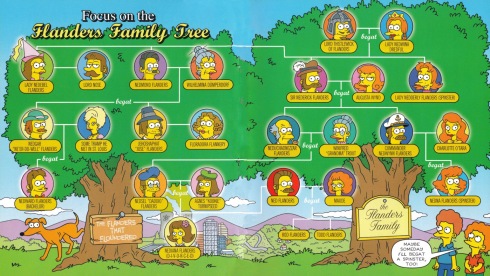 (Click 2x to enlarge, back button to return)
(Click 2x to enlarge, back button to return)
Directions for future testing?
We may have to begin to look to the 111-marker tests to see if they show any further ability to distinguish results.
We may have to compare results in more than one way: perhaps comparing fast-changing markers and slow-changing markers separately and then combining the comparisons.
Tests on more lines might tell us if discord between the results and the paper family tree is the norm or the exception. Are all the Davis genes highly active or just some lines?
And we may have to just continue mapping the Davis family tree, trying to test one descendant of each major line. We may yet find a pattern emerges if we continue to study marker changes on lines whose relationships we already know.
More cousins
Whether or not we know where we fit on the tree, each test introduces us to yet another Davis cousin, another descendant of our original immigrant ancestor. We may feel like just virtual friends, but DNA doesn’t lie. We are all connected as family, even if it is a very large family.
We currently have 25 members in the WDD Project (26 with latest match) who live all across the U.S. and we have many interested potential Davis cousins planning to test. One day in the future, we might take on the task of figuring out just how many Davis descendants William Davis has produced altogether in this clan. Of course, we might need a statistician to help.
Thanks to all of you who have queried this website and who have been so gracious to share your family information. And thanks to the contributions of Tim Davis who finds and helps fund testers for the FTdna Davis Surname Project.
If you have any questions, additional perspectives or corrections, please add them in the comment section or email me. And if you have any other Davis family information, please let me know and I will add yours to our growing collection.
Don’t forget to check the Ancestor Photos page for more Davis historical photos related to these two lines.
Until the next post, or next cousin, whichever comes first.
Best wishes,
-Jan Davis Markle, Director
William Davis DNA Project (williamdavisdna.org)
jrmarkle at g mail dot com
Proven lines, Brisley Branch, April 2014
(Click 2x to enlarge, back button to return)
Proven lines, Pavior branch, April 2014
(Click 2x to enlarge, back button to return)
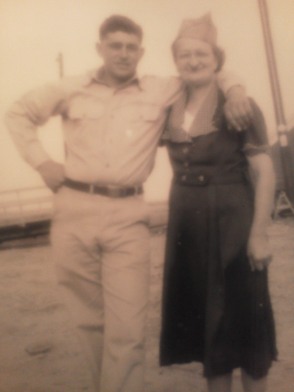
Latest DAVIS match!
Seen here abt 1951 with his mother,
Josephine (Sherman) Davis
To all members of the Davis Family and interested DAVIS researchers: we have three new Davis matches! Let’s call that four, since we have a last minute update.
It appears that we have yet another new match, a fourth one, whose 12-marker test has just come in and who descends from the Greenbriar Billy/ Rev. Peter Davis line. More on him in a later post after the rest of his markers are posted.
Our latest 67-marker match is the son of Orin Thomas Davis, b 1875 Carlston, Minnesota. He is the grandson of Stanton Henry Davis, born 1844, New York. And he is the great-grandson of the famous, (in our tree), Benjamin Davis, the one with 19 children, with his third wife, Anna Lowing.
Stanton Henry Davis was the youngest of all 19 sons and daughters of Benjamin Davis5, who had three wives, Lydia Burdick, Sally Burdick and Anna Lowing. Stanton was 10 years old when his father died in 1854 in Watson, Lewis, New York. Eleven years later, Stanton is found on the 1865 Carlston, Freeborn County, Minnesota census at age 21, and then, a year later, he married Emaline Julia Bowen.
Stanton Henry Davis and Emaline had 7 children, including one set of twins. Our current tester’s father, Orin Thomas Davis, was one of those twins and Orson Truman Davis was the other. They were born fourth and fifth.
But what was it in 1865 that attracted young Stanton Henry Davis from Watson, New York , some 1,173 miles away, along the Great Lakes, through Buffalo, Cleveland, Chicago and Wisconsin to Carlston, Minnesota?
Did it have to do with the civil war? Was it because Carlston Township was called “Stanton” township until 1858 in honor of an earlier settler named Elias Stanton? Did it have to do with the fertile soil that beckoned all farmers with a promise of bountiful crops?
It also might possibly have been love. One interesting fact is that Stanton Henry Davis’ wife, Emaline Julia Bowen, had a sister, Sarah Arvilla Bowen. Sarah married Stanton Henry’s nephew, Orville Elverton Davis, in Carlston, Minnesota, 6 months after Stanton married Emaline. Maybe it was something about those Bowen girls!
Orville and Stanton were more like contemporaries, rather than uncle and nephew, since Orville was only 5 years younger than Stanton. Orville was Benjamin Jr’s son. That is, Benjamin5, with the 19 children, had a son, Benjamin, Jr.6, and Benjamin Jr.’s son was Orville.
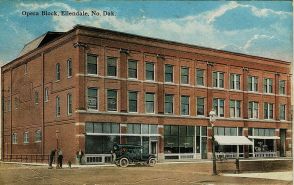
Opera Block, Ellendale, North Dakota, abt 1910
And what was it about Ellendale, North Dakota, that attracted Stanton’s son, Orin Thomas Davis, to move further west in 1914 or so? Ellendale was 225 miles due west of Orin’s home in Little Falls, Minnesota. Was it because Orin’s father, Stanton Henry Davis, had just died in 1914 in Minnesota?
Being that the town was named after Mary “Ellen Dale” Merrill, (the wife of S.S. Merrill, superintendent of the Chicago, Milwaukee & St. Paul Railroad), perhaps it was also the railroad stop in Ellendale, the first town to have a railroad in the entire region in 1882, that enticed this branch of the Davis family west.
Perhaps it was the rich, black soil and the Red River Valley “boom” that began in the 1880’s and established Fargo, North Dakota, an area 160 miles NE of Ellendale, straddling the Minnesota-North Dakota border along the north-flowing Red River, as a center for farmers.
Whatever reason brought them there, Orin Thomas Davis and his wife, Josephine Sherman, had 8 of their 10 children born in Ellendale, North Dakota, and Orin lived there until his death in 1951.
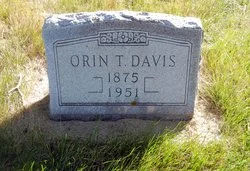
Orin Thomas Davis, 1875-1951
Ellendale City Cemetery
Ellendale, Dickey, North Dakota
Update: photo of 10 of Orin and Josephine Davis’ 10 adult children, abt 1982.
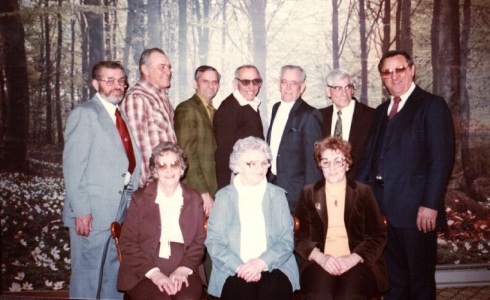 All 10 of adult children of Orin T. and Josephine Davis, about 1982
All 10 of adult children of Orin T. and Josephine Davis, about 1982
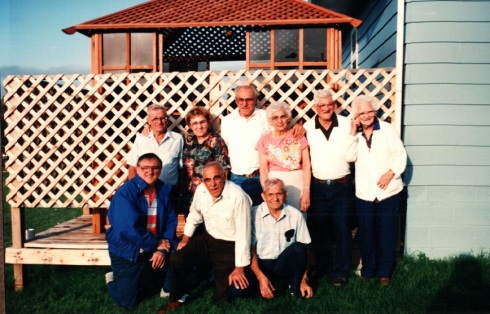
9 of 10 adult children of Orin T. and Josephine Davis, about 1986.
Our current tester, son of Orin Thomas Davis, left home at age 13 to live with his older sister in Forbes, ND. He went into the army in 1950 and served in the Korean War. When he returned, he married and bought his other sister’s farm and turned it into a dairy farm. In 1975, he sold the farm and bought the Circle Bar. He renamed it “Dale’s Corner Corral” and it became very successful. He was responsible for bringing the PRCA Rodeo to Ellendale until the city stopped sponsoring it. He sold the bar in 1997 and finally retired a few years ago. See more about his line at the William Davis DNA Project members’ tree. See more photos at the Ancestor Photos page.
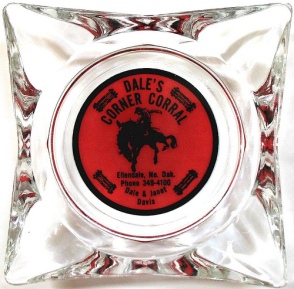 Ash tray from Dale’s Corner Corral
Ash tray from Dale’s Corner Corral
Courtesy Hock_venom, Flickr.com
Other Matches- only 12 markers
Our other two new matches are only 12-marker matches so, without further markers, they won’t give us much genealogical information except to verify their lines.
1. The first 12-marker match, Living Davis, is the son of Stuart Edward Davis, 1911 WI-1981. His line is Stuart Edward9> Samuel Peter8>Samuel Parker7>Job Greene6>Joshua5 Davis.
Congratulations all you descendants of Stuart Edward Davis! You’re in the Davis clan!
This new tester’s ancestor, Samuel Parker Davis7, was the brother of Jerome Ahira7. Their ancestor in common, 4 generations back, was Job Greene Davis, born 1799 NY, so we’d expect that #xxx088’s later markers, DYS 13-67, to closely match that of previous tester #xxx037, son of Ward Rexford10 Davis, who descended from Jerome Ahira7 Davis. We’ll have to wait and see.
2. The second 12-marker match is a brother of an already tested Davis member, #xx577, who is tentatively placed on the line next to #xxx841, Hank Davis’ ancestor, Archie Eugene7 Davis. That line is : Charles7 (brother of Archie Eugene7)>Richard Robert6>David Rogers Jr5 Davis.
No real further information there except to verify, as expected, that the test results of the brothers, #xx577 and # xxx049, descendants of Gilbert Charles Davis, are exact duplicates.
The Orin Thomas7/Stanton Henry6 Davis line stems from Benjamin5 Davis, b 1772 CT. Because Olin Cecil9 Davis also descended from Benjamin 5, that makes Benjamin5 an ancestor-in-common to both their lines.
Olin’s ancestor, William6, b 1810 NY, was the third son of Benjamin5 Davis (and first wife, Lydia Burdick). Stanton Henry6 Davis, b 1844, NY., was the twelfth and last son of Benjamin5 Davis (and third wife, Anna Lowing).
Even though they had 34 years between them and had different mothers, Olin’s ancestor, William6, was actually the older half brother of Orin Thomas’ ancestor, Stanton Henry6 Davis. Being that both these testers, Olin Cecil Davis and Orin Thomas Davis’ son, had an ancestor in common in four generations on one side and three generations on the other side, you would think that their test results would be quite close to each other, wouldn’t you?
WRONG! Just to show how variable the DNA can be, Olin Cecil’s test, which should be genetically close to Orin Thomas Davis’ line, is instead measured as being five steps away in genetic distance. Yet another Davis member, #xxx037, who descended from a more distant relationship, is shown as being only three steps away, supposedly “closer” genetically. This other line is descended from Benjamin’s uncle, Rev. David Rogers Davis, Sr. and they do not have an ancestor in common for eight generations! You would expect 8 generations would be further away genetically and show more change in markers than four generations, but not so in this case.
Take a look at the updated Proven Lines Chart on the William Davis DNA Project site to see a diagram of Olin’s and Orin’s lines, older proven lines and the relationships between them.
Lucky we usually know where to place these testers on the family tree without having to deduce it from the marker results.
Possibly, with more tests, a larger explanatory pattern, that we can’t discern at the moment, will emerge.
Analysis chart
This Analysis chart is an attempt to simplify the understanding of our testers’ differences. It tracks only the changing markers. The rest of the 67 markers are not listed because, at this point in comparison, they are the same for each tester on this chart. Duplicate testers or non-Davis surnames have been omitted. (Benjamin West DAVIS and Peter H. BURNETT lines are duplicates to #xxx841.)
Testers on this chart have been reordered in the sequence of when they occur on the family tree: oldest son and his descendants (far left of tree) are listed first; youngest son and his descendants (far right of tree), last. This allows testers descending from the same ancestor in common to be placed next to each other.
See on the Proven Lines chart how the lines descended from the first son are on the left of the chart and move to the right with the later sons.
Testers with common ancestors are shaded the same color. We would expect them to have identical or closely matching results. Theory says that the less generations between a tester and an ancestor in common, the less time for marker mutations. So testers three generations from a common ancestor probably, statistically, would have less marker changes than testers seven generations away.
Does that premise hold for our Davis testers so far? Look at the testers shaded the same colors and see the number of generations to their common ancestor. Count the number of markers that are different between them. Do those with smaller number of generations to an ancestor in common have less marker differences than those with a larger number of generations? Do you see any pattern in their results? Share your observations with a comment on this page if you’re inspired. (click on chart for larger view).
Summary of 2013 William Davis DNA Project Membership
We currently have 23 members of the William Davis DNA Project with matching tests (soon 24 members). This represents 18 distinct lines, two of which have different surnames and four of which are not positively placed on the William Davis family tree yet. Fourteen of these lines are descended from William Davis and his first wife, Elizabeth Brisley. Three of these lines are descended from William and his second wife, Elizabeth Pavior.
Thank you all for your cooperation with testing and sharing information about your lines. Hopefully we will begin to see clearer patterns with a larger number of testers.
To all you William Davis DNA Project members: if you have moved since you became a member, please contact me with your physical mailing address and look for some non-virtual (snail) mail to reach you soon. Send any change of address to: jrmarkle at g mail dot com. Don’t miss out! 🙂
Best wishes to all you Davis cousins,
Jan Davis Markle, Director
William Davis DNA Project
More History: Anna Lowing, 1802-1889
Daughter of William Lowing and Anna Haight, step-daughter of William Vaughn, married first to Eusebius Sweet and married second to Benjamin Davis.
“Written on back of photo: ‘Grandma Davis, Grandma Maxson’s Mother.’ That would be Anna Lowing-Vaughn Sweet Davis 3rd wife of Benjamin Davis and her second marriage. Child of William Lowing & Anna Haight. Step-daughter of William Vaughn & Anna Haight.”
–Courtesy of “My Family Story” by Weid427 and “Covel Family Tree” by jlrmvocel72 on Ancestry.com
Anna Lowing was the youngest of 9 children of William Lowing and Anna Haight. “Grandma Maxson” would be her daughter, Susan Belle Davis who married S. S. Maxson.
According to the story “Lowing Genealogy,” William Lowing was by born James William McLaughlin in Kingston, Jamaica in 1758 but went by the names of”MacLaughn,” “Laugh,” and”Lowing.”
James’ father, a shipping captain, died when James was 15 years old and James found himself apprenticed to a harsh captain. In running away, James, now going by William, found himself fighting indentureship of “orphans,” hence the creative invention of alternative names. After marrying, William and his wife, Anna Haight, and children lived in Vermont until they moved to Peru, New York where William died early at the age of 45. Anna Lowing, the youngest, was only 6 months old. Anna Lowing moved to Minnesota with her son, Stanton Henry Davis, and died there in 1889.
~
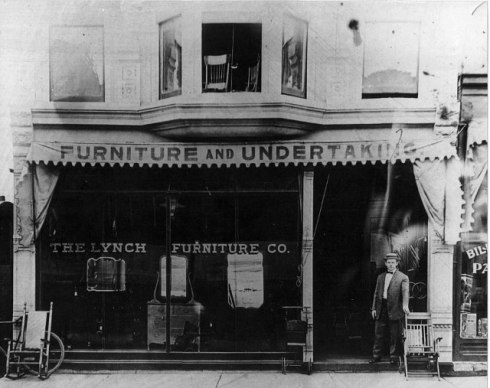 Lynch Furniture Company, Canandaigua, New York, abt 1905
Lynch Furniture Company, Canandaigua, New York, abt 1905
-Courtesy lynchfurnitureny. com
Canandaigua, NY is hometown to one of our matches below.
Since the last post, the K87577 Davis Surname Project subgroup has had 5 new matches, and 6 non-matches, bringing our total Davis matches to 20 since the first I2a1b DAVIS test result was posted in fall of 2007 (thanks to my brother, “K87577,” who agreed to participate).
NEW MATCHES
We have five new matches to learn about, compare and analyze. The analysis will come in a later post. Thanks to all those who have researched, funded and participated in these tests. The matches are:
1. son of Hayward F.9 DAVIS 1926-2000, Salem, WV (Nathan Gifford6 DAVIS line)
2. son of Sammie Charles9 DAVIS, 1932-1981, WV, ARK, TX (George Johnston5 DAVIS line)
3. son of Gerald R.9 DAVIS, 1920-2004, Troupsburg, NY (Isaiah Satterly4, b 1814, DAVIS line)
4. son of Harry Edward10 BURNETT, 1930-2007, Sussex County, NJ to Brookfield, OH (William Harrington BURNETT line)
5. son of Charles Edward MURRAY, 1924-2001, Canandaigua, NY (Joseph Edward MURRAY line)
See the updated Proven Lines Page for all 20 matches and recent non-matches.
Three of our new matches were Davis men who were expected to be matches.
FIRST MATCH
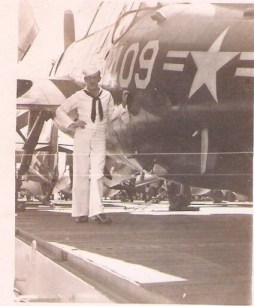 Hayward Ferrill DAVIS, 1926-2000, son of Gifford Nathan8 DAVIS, abt 1945
Hayward Ferrill DAVIS, 1926-2000, son of Gifford Nathan8 DAVIS, abt 1945
-courtesy DAVISDANIELS Family Tree
Our first expected match, is the son of Hayward Ferrill9 DAVIS, and grandson of Gifford Nathan 8 DAVIS, 1873-1929, WV (Nathan Gifford6 line). “Gifford” is a name that runs in the WV Davis lines and it refers to the wife of Rev. Nathan4 DAVIS , Anna GIFFORD, who was born in Shrewsbury, NJ. Rev. Nathan and Ann Davis were married in 1761 in New Jersey, raised their children in N.J. and migrated with some of their adult children to Salem, WV by 1795.
The current match’s line descends from Rev. Nathan4 DAVIS to his grandson, Nathan Gifford6 DAVIS, b.1814 WV, and then to his grandson, Gifford Nathan8 DAVIS, b. 1873 WV. Gifford Nathan8 DAVIS’ grandson is our current tester. That’s 3 grandfathers back, as in, “my grandfather’s grandfather’s grandfather.”
Gifford Nathan DAVIS had an unusual life. He was born in Doddridge County, WV and later lived in Ten Mile, Harrison County, WV. His first wife died when she was 20 years old. He had 2 children with his second wife in 1904 and 1905. In 1925, at the age of 52, he married a third wife who was 33 years old and had 2 more children in 1926 and 1928. He died in 1929, at age 56, and his third child of that marriage was born shortly after he died.
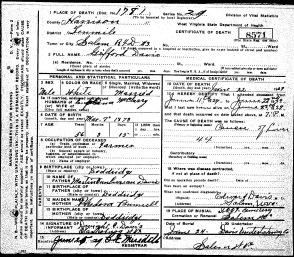 Death certificate Gifford Nathan DAVIS, 1873-1929. Note the names of the attending physician and the undertaking company (see lower right corner; click twice to enlarge). -courtesy DAVISDANIELS Family Tree
Death certificate Gifford Nathan DAVIS, 1873-1929. Note the names of the attending physician and the undertaking company (see lower right corner; click twice to enlarge). -courtesy DAVISDANIELS Family Tree
Rev. Nathan4 DAVIS is the ancestor in common for this match and for two of our previous matches. The current match descends from Rev. Nathan’s son, Stephen C.5 . The other two matches descend from Rev. Nathan’s son, William Gifford5 “Jersey Billy,” and from Rev. Nathan’s son, Annanias5.
SECOND MATCH
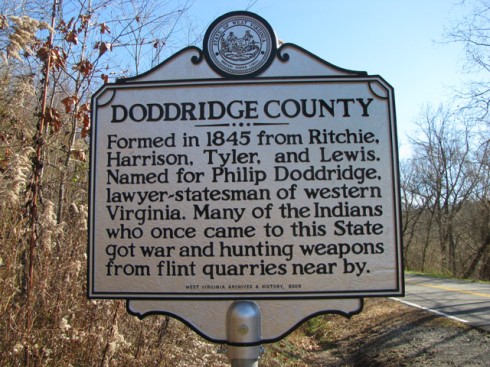
Historical Marker, Doddridge County, West Virginia
The second expected match proves the line of the son of Sammie Charles9 DAVIS, born in 1932, Lockesburg, Arkansas, who was the son of Franklin Harvey8 DAVIS. Franklin Harvey was from Union, Doddridge County, WV, and descends from George Johnston5 DAVIS and William “Greenbrier Billy”4 DAVIS.
This line of the DAVIS family migrated over the years from NJ to Doddridge County, WV, to Arkansas, to Texas and to New Mexico. Our tester says that his grandmother Rosie was a Pentecostal Holiness preacher and was 26 years younger than his grandfather, Harvey DAVIS when they had their 2 daughters and their son. Before Rosie, Harvey had 4 sons and 3 daughters with his first wife, Ellen.
Third Match
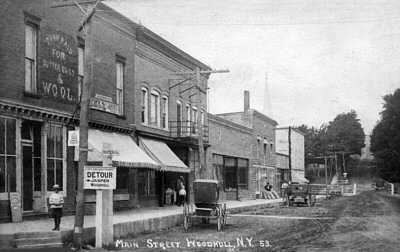 Main Street, Woodhull, N Y -courtesy Steuben Co., NY GenWeb site
Main Street, Woodhull, N Y -courtesy Steuben Co., NY GenWeb site
The third expected match proves the line of Gerald Robert9 DAVIS, 1920-2004 Woodhull, NY, descendant of Isaiah Satterly6 DAVIS, born 1814.
Isaiah Satterly DAVIS was one of the four sons of Rev. David Rogers Jr.5. DAVIS. We had already tested a descendant of another of those four sons, Jesse L.6 DAVIS, resulting in the matching Russell DeForest9 line.
Isaiah Satterly’s son, Richard, was born in Troupsburg, Steuben County, NY, as were Richard’s six sons and his grandson, Gerald Robert DAVIS. Gerald Robert DAVIS died in Woodhull, NY, 13 miles from Troupsburg.
Troupsburg, NY is on the border of NY and PA, and was named after Colonel Robert Troup, Esq, a land agent for the Pulteney Estate, a large tract of land stretching from Sodus Bay on Lake Ontario, south to the Pennsylvania border.
NON-DAVIS SURNAME MATCHES
Two of our matches carried surnames other than Davis. These non-Davis matches were complete surprises and makes one wonder just how pervasive the Davis clan is.
First non-DAVIS match
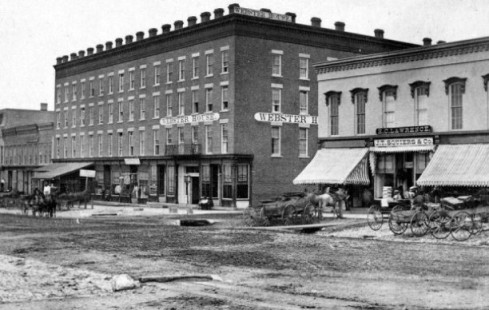 Main St., Canandaigua, New York
Main St., Canandaigua, New York
-Ontario County Historical Museum
The first non-Davis match carries the surname MURRAY. The line of his father Charles Edward MURRAY, 1924-2004, leads back to Canandaigua, Ontario County, New York (28 miles south of Rochester, NY) and before that, his Scottish family, Patrick MURRAY, a shoemaker, and his wife and son, immigrated from Scotland to Canada in 1880 and then down to Rochester, NY in 1886. Our Murray tester and his sister are studying their complex Murray family tree to see where their clan might overlap the known Davis family tree, in recent times or in distant Scottish days.
Second non-DAVIS match
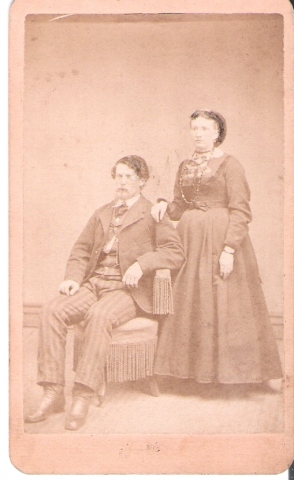
Peter H. BURNETT (son of William Harrington BURNET) and wife, Bethsheba AXTELL -Photo courtesy of Burnett Baum Family Tree
The second non-Davis surname is BURNETT. Harry Edward BURNETT, 1930-2007, the father of our BURNETT tester and his two researcher sisters, came from Brookfield, Trumbull County, Ohio and before that his ancestors came from Sussex County, New Jersey.
William BURNET, the oldest male ancestor on their line, was born in 1771 in NJ and was believed to be a HARRINGTON who was adopted by the family of Grace BURNET, William’s mother.
The William Davis clan had left Rhode Island and lived in Shrewsbury, NJ from 1745 to 1787, so the Davises and the Burnets were in the same vicinity around the time William Harrington Burnet was born. It is not inconceivable that he might have been a DAVIS from those earliest years but such a theory is only proven by testing more men in each generation on his line.
William Burnet migrated with his wife and children and 2 uncles from NJ to Ohio in 1801. They were the quintessential settlers, clearing the land with hand tools and building a log cabin from the cleared trees. William had two wives and 11 children. One of William’s sons, born shortly after their arrival in Ohio, was the first male child born in Hubbard township.
The History of Trumbull & Mahoning Counties, Ohio said that William was 91 when he died in 1863 and there were “now living in 1882, as his descendants–4 sons, 2 daughters, 56 grandchildren and 79 great-grandchildren and sixty-two great-great-grandchildren, a total of three hundred and three persons.” That was 1882. How many descendants might there be now?
It is interesting that the Burnett tester is an exact match to two other previous Davis matches: first a match to the Benjamin West DAVIS line, who came from Caneandea, Allegany, New York, and second a match to the Henry Raymond DAVIS line who migrated from Lincklaen, NY to Breed, Wisconsin and later, Washington State. The significance of these three lines matching exactly is yet to be determined as their records do not overlap in any discernible way.
Non-matches
1. Leon Horace DAVIS 1920-1969 (Nathaniel and Benjamin DAVIS line, Warwick, Orange Co., NY, ):R1b1a2.
This result disproves the connection, claimed by some online, between William DAVIS b 1663 and Nathaniel DAVIS or his brother, Benjamin DAVIS, b 1757, of Warwick, Orange County, NY.
Those claiming to be descended from William b 1663 via Benjamin Davis of Orange County, NY will have to consider that William Davis most probably isn’t an ancestor of Benjamin since descendants of William show I2a1b haplogroup and Benjamin’s brother, Nathaniel, shows a different haplogroup, R1b1a2. This infers that William and Nathaniel (and brother Benjamin) descend from different ancestors. Definitive proof of this theory would require more testing of other generations of Nathaniel and Benjamin Davis’ line.
2. Billy Joseph DAVIS, 1933-2006 (William DAVIS line, NC):R1a1a
More non-matches (special thanks to Tim Davis for research and funding):
3. James Arlo DAVIS 1923-1994 (Seth DAVIS 1796-1864, s/o David DAVIS and Betsey Hammond of Long Island, NY of the Foulke DAVIS line): R1b1a2
This result disproves the claim that Seth DAVIS was a descendant of William DAVIS, b 1663, and instead connects Seth to Foulke DAVIS of Long Island, NY.
4. Elgan Allen DAVIS (John O. DAVIS line, Wales) : haplogroup G
5. Earl DAVIS, 1912-2007 (Charles E. DAVIS line, Monmouth, NJ ):haplogroup I
6. Alburn Wesley DAVIS (Ebenezer DAVIS b 1741 line): R1b1a2
See the Proven Lines page for the complete lines of matches and non-matches.
The Odds of Testing
Check back or subscribe to feed (top of page, on left) for news on the latest tests from our unique cluster of Davis family members. I say unique because on the DAVIS Surname project, the other haplogroups (like R1b1a2) outnumber us (I2a) 15:1. So I2a DAVIS men are a less common haplogroup amongst the sea of R1b1a2 DAVIS men.
This is unfortunate because if you test a random DAVIS man, without some written records indicating a relation, the odds might be 15 to one he is not a match to you.
But this is fortunate because, if you do find a man who carries the DAVIS name and who tests I2a at 12 markers, you can be confidant that they are in the DAVIS clan. So far, that is. With many more tests, that may not prove to remain so, but for now it has. With other surnames, a match at 12 markers often no longer matches when the 25-67 markers are tested.
If you or members of your family carry the DAVIS name and you wonder if you are a descendant of William DAVIS b 1663, Wales, write a comment, or email me, with your line from father or grandfather to your oldest known ancestor, preferably with their birth and death dates and places, and I’ll see if I can find out more about your family and how you might be connected.
-Jan Davis Markle
jrmarkle at gmail dot com
NEW MATCH
We have a new Davis member of the William Davis DNA Project. He is Kit #201748 on the FTDNA Davis Surname Project. He descends from Annanias Davis, born 1784, the son of Rev. Nathan Davis, Sr.
His line is Rev. William1, John2, Rev/Capt Thomas William3, Rev. Nathan4, Annanias5, Nathan6, Marion C.7, Edward H.8, Edward H. Jr.9, living Davis10.
Annanias came from Salem, WV to Ohio and then to Sullivan County, Indiana and Annanias’ son, Nathan, continued northwest from Indiana to Welton, Clinton County, Iowa.
MATCHES
Our new match closely matches (1 step off at 67 markers) three of our other William Davis DNA Project members.
Our new member first matches the tester who descends from Annanias’ brother, William Gifford “Jersey Billy” Davis, both sons of Rev. Nathan Davis, Sr.
William Gifford “Jersey Billy” Davis was the oldest, born in NJ in 1762 and was 22 years older than Annanias Davis (and Annanias’ twin brother, John) who were the youngest, born in NJ in 1784. (See their lines on the far left of the “Proven Lines” chart.)
This first match shows the same marker results at DYS 391, both of them=10, which sets them off from the rest of the group, who all have DYS 391=11. Although they match at DYS 391, their match is not exact because they differ 1 step at DYS 576, considered a “fast” changing STR (short tandem repeat) marker, more likely to change within a genealogical time frame. Our new member shows DYS 576 =21 and our older member shows 576=22. Even with only one marker one step off, their common ancestor is still 7 generations ago.
Our new member’s other close match is the member descended from Rev. David Rogers4 Davis, Sr., first cousin to Rev. Nathan 4 Davis, Sr. The one step off at 67 markers for this match is at DYS 391, our new member with 10, and our old member with 11. These two matching lines are 8 generations away from an ancestor in common.
The third match is an identical match to another test, but we don’t have any genealogical conclusions from the match because it is as yet unplaced on the Davis family tree.
One thing we can observe from these two matches is that two Davis men can match 1 step off and still not have an ancestor in common for 7 generations. When predicting ancestry in common, this is a fact we can rely on, rather than guessing with statistical probability.
UPDATE: Our new member also matches one of our current members with a genetic distance of four steps off. Their Davis ancestors in common are Rev. John2 Davis, b. 1692, and Elizabeth Maxson, 7 generations ago.
Four steps off is not usually close enough to comment on but this same current member’s mother’s line descends from the same ancestors in common as our newest member, just 5 generations ago: Annanias Davis, b 1784, and Rebecca Clayton.
Our current member’s line on his mother’s side is: Rev. Wm1, Rev. John2, Thomas3, Nathan4, Annanias5, William Clayton6, Thomas Clayton7, Effie Irene8 Davis, Ruth Marie Sholtz9 [who married LaVerne W.8 Davis], Living10 Davis, Kit #152496. Ruth Marie Sholtz9 and La Verne W. 8 Davis were 6th cousins, once removed.
LaVerne8 Davis’ line, Kit # 152496’s father’s line, is: Rev. Wm1, Rev. John2, John3, Thomas4, Benjamin5, William6, Henry Eugene7, LaVerne8, Living9Davis. This is the line that is 4 steps distant from our newest member.
Unfortunately the Y DNA test only tests the male line so we cannot see how close our current and newest members are via Annanias5.
See all these lines on the proven lines chart.
DAVIS STORIES
Our new Davis member comes with stories from his Davis ancestry which he is happy to share with us. Here is an excerpt from the Sabbath Recorder about Annanias Davis and his wife Rebecca Clayton.
The Sabbath Recorder; Feb. 19, 1852
Western Correspondence
(Letter to the editor, dated Jan. 18, 1852)
In this place, Sullivan, the county seat of Sullivan County, I have incidentally met with a number of Sabbath-keepers, adhering to the law of the Lord; and testifying to all around of the obligation of all men to remember the Sabbath of Jehovah. the head of this interesting group is Annanias Davis, a son of Nathan Davis, Once of Salem, Virginia, whose family was part of the colony that removed from Squan River, in New Jersey, to western Virginia, Sixty-one years ago (1791), at which time the subject of these remarks was nine (born abt. 1782) years of age. The family name of his wife , who is in like manner zealous for the sabbath observance, was Clayton, and she belonged to a family who were formerly connected with the same Christian Fraternity. Annanias Davis removed from Vireto, Warren Co., Ohio forty-three years ago(1809), and thirteen years ago (1839) to this place, at that time, a dense and almost unbroken forest. It being the center of the county, by vote of the inhabitants, the county seat was removed here five years ago( 1847), which has given increased value to their lands, and importance to their location. During the whole thirteen years of their residency here, they have not heard a Sabbath Keeper preach nor even seen a single person of their own faith nor read a Sabbath publication, the Bible alone excepted; and yet they have steadily kept to the “Ancient and Honorable Way”. The posterity of this worthy couple now number Sixty-five souls; their own children are five sons and four daughters, with their families, most of them observers of the Sabbath. From the I gave them, they have concluded to send for the Sabbath Recorder. Having no public gifts among them, for nine years they lived without any church privileges; but for four years past, most of them have united with the Christian Church in this place, with the express agreement, that they may keep Jehovah’s holy day, and be subject to neither censure nor discipline for pursuing their worldly business on the first day of the week, so that they do not habitually neglect public worship in the church to which they belong. Their learning is chiefly the “one-book” learning; and that they have “right smart.” Although they have no public gifts, their honest and Christian behavior has gained for them a good report of all men where they are known. They have often been assailed by the opponents of the seventh-day Sabbath, but have so successfully used the armor of righteousness as to put to silence their opposers; and a considerable portion of the community around them have learned to say, “If there is any day of rest binding by Scripture now, it is the seventh day.” S. D.
MIGRATION TO WELTON, IOWA
The following is a story about Annanias’ son, Nathan Davis and his wife, Nancy Doty, and also about Nathan’s son, Marion C. Davis and Marion’s son, Ed Davis, written by our new member’s living aunt:
“At the time of the civil war, Nathan and Nancy Davis came to Iowa from the Terre Haute area of Indiana, traveling with their family in a covered wagon. They homesteaded a farm near the small town of Welton, in Clinton county.
Marion Clinton married Libby Mathers and they had two sons, your grandfather, Edward Harrison and William. Edward was about 2 years older than Will. Marion and Libby separated when the boys were quite young and Ed went to live with Marion’s parents while Will was raised by Libby’s parents. They did not know each other until Ed as a young man traveled by horseback from the Welton area in eastern Iowa to Rinard which is in Northwest Iowa. Must have been quite an adventure.
In later years, Marion made his home with Ed and Emma in Lyons (which is now part of Clinton). He developed cataracts and lost his sight. In 1926 Emma passed away and, after a time, Ed and Grace were married.
In the early 1920’s, Ed was driving a team of horses on the frozen Mississippi river when the ice broke and he found himself under the horses who were kicking their legs trying to swim. Somehow he managed to get hold of the harness and pull himself up to the surface where he could grab on to the edge of the ice and pull himself out of the hole. This happened in a very isolated area so he had to walk quite a long way to a cabin where the man that lived there gave him lots of hot coffee and dry clothes, then proceeded to take him into town.
At first, they told Ed that he might lose both hands but there was a young doctor who thought that just by removing the infected tissue he could save the hands. He lost part of one of his little fingers to the middle joint and three fingers to the first joint. He was always grateful that he could still work and earn a living, although in later years he had very painful arthritis which they thought was attributed to the accident.
Ed worked for the city of Clinton and had two mules. He would plow gardens and do odd jobs with them. Edwin says the name of the mules were Jack and Speck. Ed was very attached to them.”
WILLIAM DAVIS DNA PROJECT FAMILY TREE
We are happy to add this new Davis descendant to our William Davis DNA group. See all his ancestors and their relationships, and find some connections to your own Davis line, on the new William Davis DNA Project family tree. If you are a member of the William Davis DNA Project, you can edit your own facts online. Looking forward to more Davis connections!
– Jan R. (Davis) Markle
CALEB H.DAVIS MYSTERY SOLVED?
by Jan R. (Davis) Markle
The results for the latest test of a descendant of Caleb H. Davis have come in and he tests R1b1b2, NOT I2a. William Davis’ haplogroup is I2a so our tester is probably from the Robert Davis and Susannah Hart line but, assuming there has been no recent adoption, most certainly is not descended from William Davis, born 1663, Wales.
Thanks to Matt Davis for his contribution to this search. There are now 7 members of the Caleb Davis 1746 Delaware R1b1b2 group. See the Davis Surname Project site for a listing of those members.
Update: As of Sept 2017, there are currently 11 matching testers in the “Caleb Davis 1746 Delaware subgroup” of the FTDNA DAVIS DNA PROJECT. They are haplogroup R-M269 (R1b1b2 old group).
See Tim Davis’ thoughts on this non-match below.
And where will our next Davis search take us? Seems like it might be anywhere since the Davis family seems to be everywhere! Would love to hear from you if your last name is Davis and you have any kind of mystery in your family history that you’re hoping to solve.
If you have any reason to think you are a descendant of William Davis, born 1663 Wales, we would most love to hear from you. It’s great fun to connect to Davis cousins, so drop us a note. Your Davis line could be our next fascinating search!
Another Mystery – Partly Resolved!
by Timothy W. Davis
“Or, will DLMD be a member of a different Davis family?” That IS the answer.
DLMD’s Y-DNA results show that he is not a member of our William Davis family, but another Davis group.
The advantages of doing the Y-DNA testing for potential family members is that if they are not part of our family, they may contribute a new branch, as in DLMD’s case, to another growing Davis family.
Unfortunately for us, this means that we do not have descendants from any “Branch 2” (from William Davis and Elizabeth Pavior) sons, other than James. Nevertheless, we will continue the search.
We encourage all Davis males, and their female relatives who might be the genealogists, who visit this site to order a Y-DNA Marker testing kit through the Davis Surname Project, either 12 , 25 , 37 or 67 Markers, to see where you connect on the Davis family tree.
Another Mystery?
by Timothy W. Davis
Recently, owners of several Ancestry.com family trees have listed a “Caleb H. Davis” (1746-1820) as a son of Thomas “William”2 Davis, son of William1 Davis, our immigrant ancestor, and his second wife, Elizabeth Pavior.
However, both Susie Davis Nicholson in her book “Davis, The Settlers of Salem, West Virginia”, and G. Maria Davis Johnson on her website “Davis and Allied Families”, list only Thomas, Jr., Lydia and Joseph as the children of Thomas “William” Davis. The Ancestry.com trees listing Caleb as Thomas “William” and Bethiah’s son are without sources, except for one. The one source, with attached record, is a West Virginia Estate Settlement, dated 1823. Caleb died in West Virginia on 12 Mar 1820, consistent with this record.
Interestingly, what we know about Caleb is that he was born in 1746 in Cedar Hundred, Sussex, Delaware. Thomas “William” and Bethia Maxson’s other children, Thomas Jr., and Joseph, born before Caleb in 1738 and 1740 respectively, and Lydia, born after Caleb in 1749, were all born in Rhode Island. Does this mean Caleb is from a different family? Is it possible that Caleb was born in Delaware while his siblings were born in Rhode Island?
In 1746, the year of Caleb’s birth, Thomas and Bethia apparently traveled to Pennsylvania to live with Thomas’ brother, Joseph. It is possible that they traveled by boat and, while in route, stopped at Sussex, near Lewes, Delaware and Caleb was born there. It is not “inconceivable” that Caleb, who was born in Delaware, could be their son.
And what if Caleb H. Davis was the son of Thomas “William” Davis and Bethia Maxson? If so, we will have traced the first line of a son, other than James, of William Davis and his second wife, Elizabeth Pavior, to a living male descendant. See chart below to follow Caleb’s line. (Click on chart to enlarge.)
Also, if so, we should be able to determine if it is James or his half-brother, Rev. John Davis (son of William Davis with his first wife, Elizabeth Brisley), who has the mutation that distinguishes their lines at DYS YCA IIb. So far, all of the Y-DNA participant descendants from John have 20 alleles at DYS YCA IIb, whereas all descendants from James have 22 alleles at DYS YCA IIb.
There has been no record found yet that makes reference to Caleb as a son of Thomas “William” Davis and Bethia Maxson.
Nevertheless, we will find out if Caleb H. could be the son of Thomas “William.” DLMD, who is a descendant of Caleb and Caleb’s wife, Leah Basnett, has agreed to participate in our William Davis DNA Project. His Kit #176019 (Y-DNA67) results should be arriving about May 7, 2010.
Will DLMD match us and add a previously unknown branch to our William Davis family tree? Will his YCA IIb alleles be 20 (John)? or 22 (James)? Or, a completely different number?
Or, adding more mystery, will DLMD be a member of a different Davis family tree?







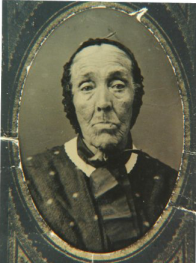


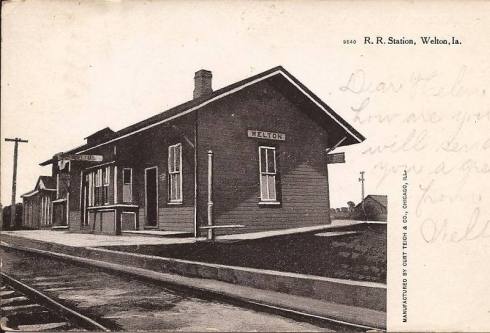


Recent Comments